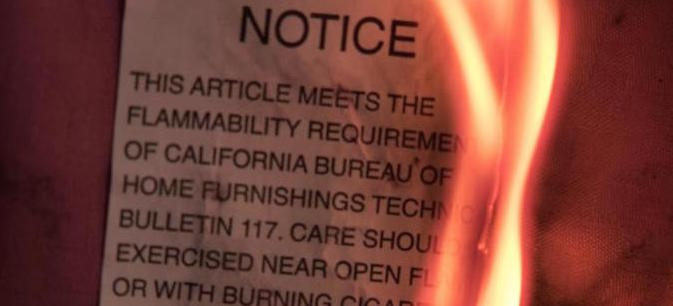Flame Retardant Chemicals: What We’ve Learned
In 2014, we were honored to host Arlene Blum, long-time advocate against flame retardant chemicals and one of the stars of the HBO Documentary Toxic Hot Seat, at our San Francisco store. We first screened the movie and then Arlene gave a fascinating presentation, moderated by a representative of the San Francisco Department of the Environment. Below are some notes we came away with after this extremely informative evening.
TB117
In 1975, a new law was introduced in California to prevent fire deaths and injuries caused by the increase in cigarette related fires around that time. It was called Technical Bulletin 117. You may recognize seeing a label with “TB117” on your mattresses or couch cushions. The law mandated that all fabrics sold in California had to meet a certain flammability standard (it had to resist exposure to an open flame for 12 seconds). Furniture makers responded by introducing flame retardant chemicals to the highly flammable polyurethane foam inside.
TSCA
In 1976, a law passed called the U.S. Toxic Substances Control Act (1976). It was meant to be a control for toxic chemicals, however in the years since it was passed, it has banned very few chemicals. Of the thousands introduced since then, 85% have no health data associated with them at all. On top of that, the law allowed for 62,000 chemicals that had previously existed to be “grandfathered” and allowed to be sold going forward without any testing. This included the flame retardant chemicals used in most furniture.
These flame retardants have been linked to serious health problems, including cancer, developmental problems, neurological deficits and impaired fertility.
PBDE
One such chemical was PentaBDE. This was used as a flame retardant from 1975 to 2004 to meet TB117, before it was banned in many products.
The long-term health effects of PBDE found in animals include:
• Endocrine disruption
• Neurodevelopmental
• Reproductive system effects
• Immune suppression
• Cancer
In addition, higher amounts of PBDEs found in people have been associated with:
• Lower birth weight
• Impaired attention
• Poorer coordination
• Lowered IQ
• Longer time to get pregnant
• Altered thyroid hormones
In 2006, PDBE was banned in California. Furniture makers began using TDCPP (or Tris), a known carcinogen, as an alternative.
TRIS
In the 1970s, Dr. Blum, proved that the flame retardant brominated Tris was showing up in children’s urine after they had slept in tris treated pajamas. This led to tris being banned in pajamas for health concerns, but it was replaced with other chemicals, and tris continues to be found in other children’s products, including nursing pillows. In a recent study brominated Tris was found in 75% of homes.
Babies
Flame retardants escape from household products and settle in dust. That's why toddlers, who play on the floor and put things in their mouths, generally have far higher levels of these chemicals in their bodies than their parents. They are also passed down from mother to child. A typical American baby is born with the highest recorded concentrations of flame retardants among infants in the world.
Fire Fighters' exposure
A separate study, published in October by the National Institute for Occupational Safety and Health, evaluated the health of nearly 30,000 career firefighters in San Francisco, Chicago and Philadelphia. Researchers found higher rates of prostate cancer, kidney cancer, multiple myeloma, and other cancers compared with the general population.
Effectiveness
As argued by Blum and others, a 2012 investigation by the Chicago Tribune uncovered that those additives may offer no meaningful fire protection. In a real fire, the upholstery fabric, typically not treated with flame retardants, burns first, and the flames grow big enough that they overwhelm even fire-retardant foam. The need for flame retardants however was being pushed on Congress by what seemed like a group of concerned fire safety advocates.
The chemical lobby
A lobbying group called “Californians for Fire Safety” paraded a series of burn victims in front of Congress to fight for the need for flame retardant chemicals. A reporter from the Chicago Tribune uncovered the only 3 contributors to this group, the 3 biggest manufacturers of chemical flame retardants:
- Albemarle
- Chemtura
- Israel Chemicals-Ltd (ICL)
Flammability standard suspended!
California Flammability Standard TB117-2013 was introduced enabling upholstered furniture to more easily pass the standard without flame retardants.
- Implemented on January 1st, 2014
- Mandatory on January 1st, 2015
- 85% of fabrics already pass
- 15% need non-FR polyester batting between fabric and foam
This does not mean that all other consumer product manufacturers are going to stop using FR’s. Even with upholstered furniture, it is still a buyer beware scenario. Consumers will need to ask if there are flame retardants used in the furniture they are buying. Hopefully, a law will be enacted soon to mandate labeling when flame retardants are used, but that is not the case today.
Baby products are exempt from the standard so flame retardants will not need to be used on strollers, baby mattresses, or nursing pillows anymore. This is wonderful news! The only exception is car seats, which are governed by the laws that dictate flame retardants in cars. Therefore, all car seats must use some type of flame retardant chemicals. Hopefully that law will change soon. Sprout suggests taking your baby out of the car seat for walks and naps to lessen the exposure.
What should you do with flame retarded foam?
There are now places that will take back your old foam cushions and replace them with cleaner foam cushions that should fit right into your upholstery. You can find a provider near you here. http://greensciencepolicy.org/safer-sofa/


